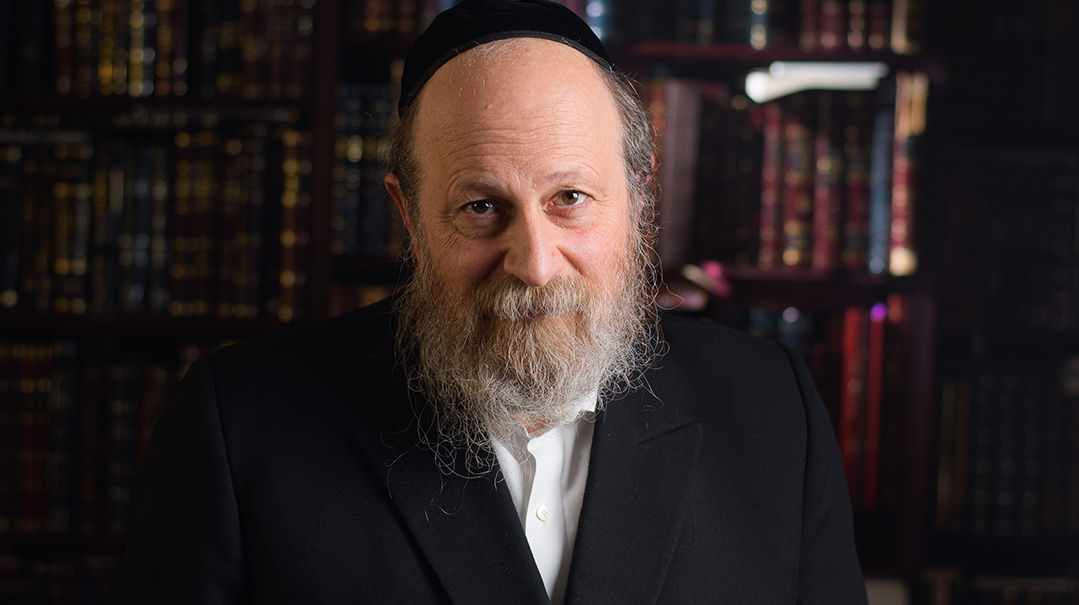Bound for Eternity

Rav Moshe Weinberger still holds tight to his father’s tefillin and simple faith

Photos: Naftoli Goldgrab, Family archives
One Shabbos about a year ago, I joined Seudah Shlishis at Yeshiva Ateres Shimon in Far Rockaway, an extraordinary place bursting with young men who maybe didn’t have an easy time of it, who’d fallen or been nudged out of the system. The yeshivah has welcomed them, reassured them, restored them, and there, in a darkened room, the Rosh Yeshivah, Rav Mordechai Yehuda Groner, was speaking to the boys lining both sides of a long table.
He was talking about the eternity of the neshamah, of its essential purity, and he suddenly cried out, “You guys saw the tefillin. You saw them. You know that those are your tefillin too.”
I had no idea what he was talking about, so after the derashah, I asked the boy next to me. There was something resolute in his eyes as he told me that the bochurim had joined the Rosh Yeshivah on a shivah call a few blocks away, where they had been menachem avel Rav Moshe Weinberger, spiritual leader of Woodmere’s Congregation Aish Kodesh, who was mourning his father. And there, they had seen the tefillin of Mauthausen — the straps that had given their owner ropes to climb above the pain and despair — and in his words, I heard a different story: A bochur who had never been beaten by a Nazi, never been forced to stand straight in freezing rain for roll call, never been crammed into a cattle car, but still carried wounds. He had both his parents and lived in a privileged generation, but in a way, he too was alone.
And the tefillin in that house? They were his tefillin too.
At the levayah of Reb Mordechai Aryeh Yosef Weinberger a few days earlier, the niftar’s grandson, Asher, had addressed his own father, Rav Moshe, telling those gathered, “Dad, those of us on the inside track understand that the thousands of shiurim and millions of words you have spoken over the years contain one single unifying theme. A noble, maybe desperate attempt to articulate the idea, the symbol, that Zeide represented, and the world that once was.”
I’m certainly not qualified to assess the accuracy of the comment, but it does explain a lot: how the shiurim, the lectures, the informal conversations of the rav of Aish Kodesh burst with ga’aguim, longing, for something undefined, unexpressed — a goal impossible to cram into a subhead or shiur title.
Others have tried to find words: “neo-chassidic” and “conceptually chassidic” and a particularly presumptuous term I saw in an article, “socially-conscientious chassidic” — as if the Rebbe Reb Meilech and the Berditchever had it almost right except that they didn’t recycle.
In that hesped, Asher Weinberger got it.
Yes, the Baal Shem Tov enlightens, the Piaseczna Rebbe inspires, and the tzaddikim of today uplift, but it’s as if Rav Weinberger is crying, “Guys, don’t miss the boat, hold tight to this Yiddishkeit too!”
It was the pure Yiddishkeit of Martin Weinberger, a quiet man from Queens who owned a chain of dry cleaners.
“My father wasn’t a big talker. He chose his words carefully, so his gestures or expressions conveyed a lot,” recalls Rav Moshe Weinberger. “Once, though, when I was a young boy, I was listening to him talk about the forced journey from Ungvar, his hometown, to the labor camps. Hundreds of people were crowded together, in impossible conditions, but my father remembered how the tzaddikim were davening Kabbalas Shabbos. He was speaking with such reverence about the groisse Kabbalas Shabbos of these Jews on their final journey. I’m not sure what I was thinking, but I asked him, ‘What happened with all those Yidden from the groisse Kabbalas Shabbos?’ In other words, what did it ultimately do for them?”
Now, sitting at a kitchen table, bare except for two coffee cups and a closed Sefer Tehillim, Rav Moshe Weinberger shrugs and makes a face, as if to say what do you want, I was a kid.
He doesn’t overdo it with the explanation or apology, though, because this too is a big part of Rav Weinberger’s message: that it’s no shame to be a human being, and it’s no great disgrace to have acted like a child when you were one.
And asking an honest question? That’s something to be proud of.
Where was Hashem in the Holocaust?
Martin Weinberger heard the question, but he didn’t answer his son. Not right away, anyhow.
Oops! We could not locate your form.












